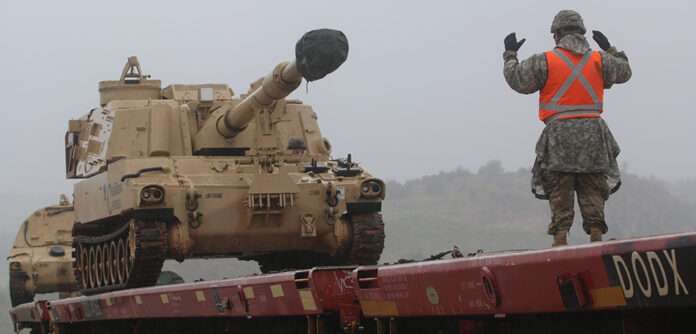The latest US weapons package to Ukraine, worth an estimated $2.85 billion, is being billed as a potential game-changer as key offensive platforms are being included for the first time.
The package includes 50 Bradley Fighting Vehicles, a medium-armored platform armed with a 25-mm gun that can provide safe transport for up to seven soldiers (depending on the variant), in addition to a crew of three. The Bradley has a top speed of around 38 miles per hour and is also armed with an anti-tank TOW missile launcher, the eponymous ‘tank-killer.’ The platform will be a natural complement for combined arms operations in the flat expanses of the Donbas; however, it will take several weeks of transport and training time before they can actually be deployed on the battlefield.
Reports indicate that the variant being sent to Ukraine is the M2A2 ODS, a somewhat recent modification created based on the combat experience of Operation Desert Storm. The variant includes a new laser range finder, a TACNAV GPS and compass, a first-generation guided missile defense system, and improved thermal imaging.
News of the Bradley delivery comes in the wake of similar announcements from EU allies, which taken together represent the first donations of light tanks/IFW from Western allies. France has agreed to send AMX-10 fighting vehicles, and Germany 40 of its Marder armored vehicle platform. Germany has also announced that it will be joining the United States in providing Patriot air defense systems to Kyiv.
The above deliveries aim to provide a much-needed boost to Ukraine’s counter-offensive capacity, but they still fall short of the battle tanks that the Ukrainian government has been requesting, notably German Leopold-2s or US M-1 Abrams. Yet it’s possible that these infantry fighting vehicles may be a impromptu test-run meant to assess whether the AFU can manage the support needed to fuel and repair them, as the logistical burdens of battle tanks would be considerably higher (for an overview of the Bradley’s abilities and support requirements, read Mark Hertling’s first-hand account on The Bulwark).
The Bradley may not be a tank, but it will synergize well with the even more noteworthy inclusion in this latest arms package: the M109 Paladin. The Paladin is a 155 mm self-propelled howitzer, and the 18 being sent in this package mark a first for Ukraine (the package also includes 36 105mm towed howitzers, adding to the 178 already provided in past deliveries). The M109 features a crew of four and its main turret has a firing range of up to 40 km, depending on the round being used (standard ammunition has a range of 24 km); its top speed is around 39 miles per hour.
The Bradleys and Paladins are meant to help Ukraine ‘retake territory,’ as stated by Deputy Assistance Defense Secretary Laura Cooper when detailing the latest package. Across frontlines that have largely ground to a stalemate as both sides fight for inches, the AFU can utilize drones to reconnoiter soft points in the Russian lines. Then, Paladins and other howitzers can unleash a barrage ahead of Bradleys quickly moving troops in to take advantage of any holes created in the defensive line. Such tactics are in keeping with the combat paradigm that is crystalizing in eastern Ukraine, that of slow and vulnerable tanks, ubiquitous drones, and a premium on mobility and combined operations.
In addition to the above platforms, the latest package also includes:
- 100 M113 Armored Personnel Carriers
- 55 Mine-resistant Ambush Protected Vehicles (MRAPs)
- 138 High Mobility Multipurpose Wheeled Vehicles (HMMWVs)
- RIM-7 Sea Sparrow surface-to-air missiles (originally a sea-based missile, the RIM-7 is being integrated into Ukraine’s land-based BUK launchers; it can be used to shoot down aircraft or cruise missiles at a range of 12 miles)
- Assorted ammunition (artillery, mortars, anti-armor mines, rockets, etc.)
- Claymores, anti-personnel munitions, night vision optics
- Spare parts for provided platforms
The package adds to an estimated $50 billion in US assistance provided to Ukraine through 2022, a figure that includes humanitarian ($9.9 billion), financial ($15.1 billion), and military support ($22.9 billion). Another $45 billion worth of aid has been approved for 2023; however, future packages could encounter new political hurdles in the Republican-controlled House of Representatives, as Republican Kevin McCarthy reportedly made promises to cut aid to Ukraine to secure his election as Speaker of the House.




